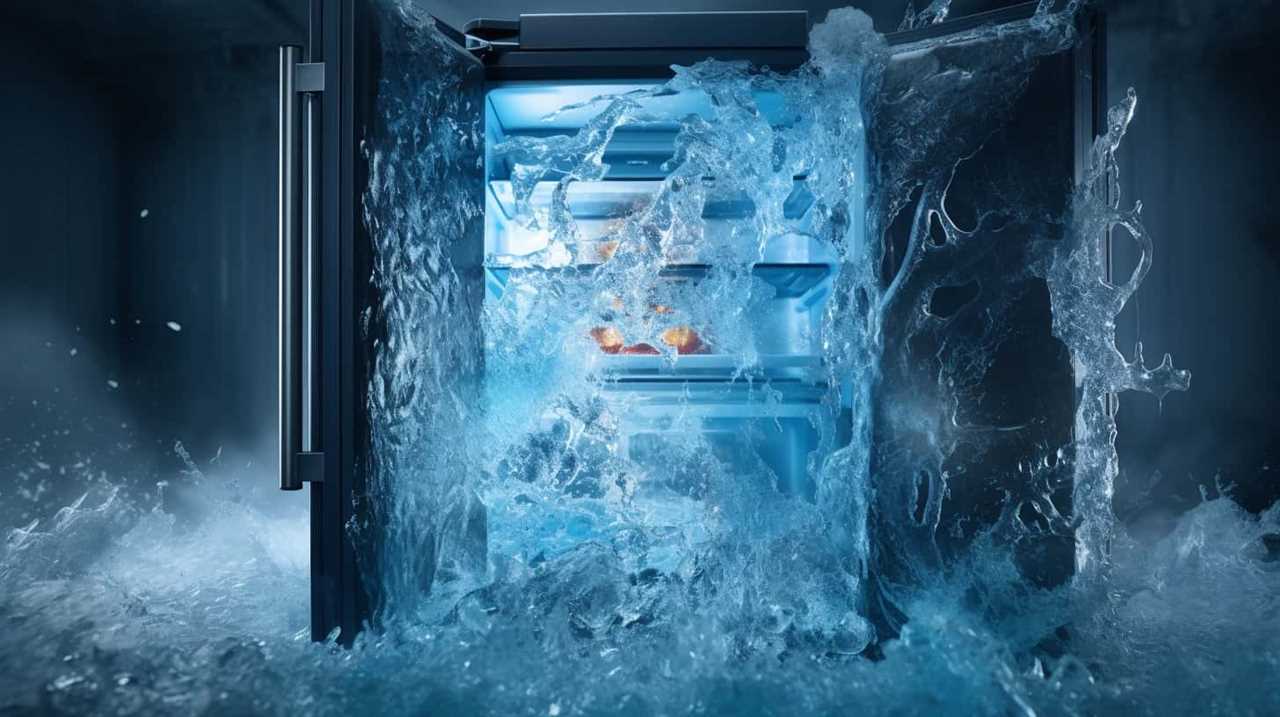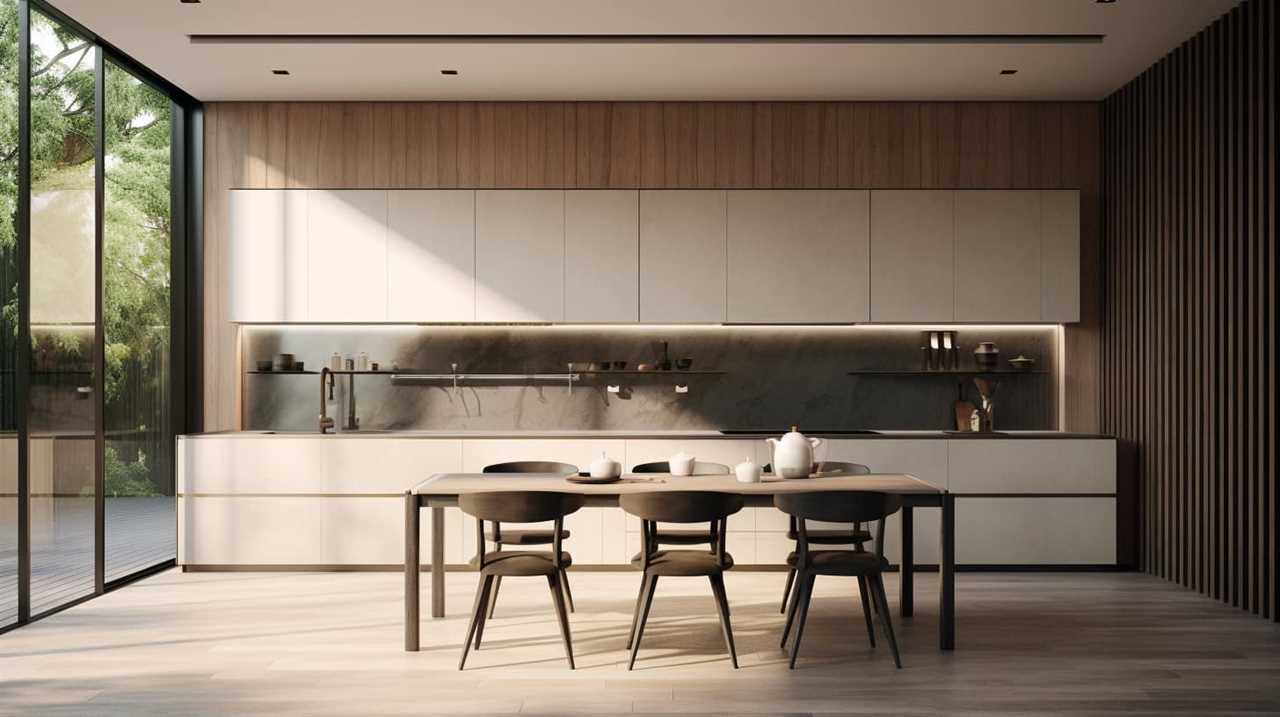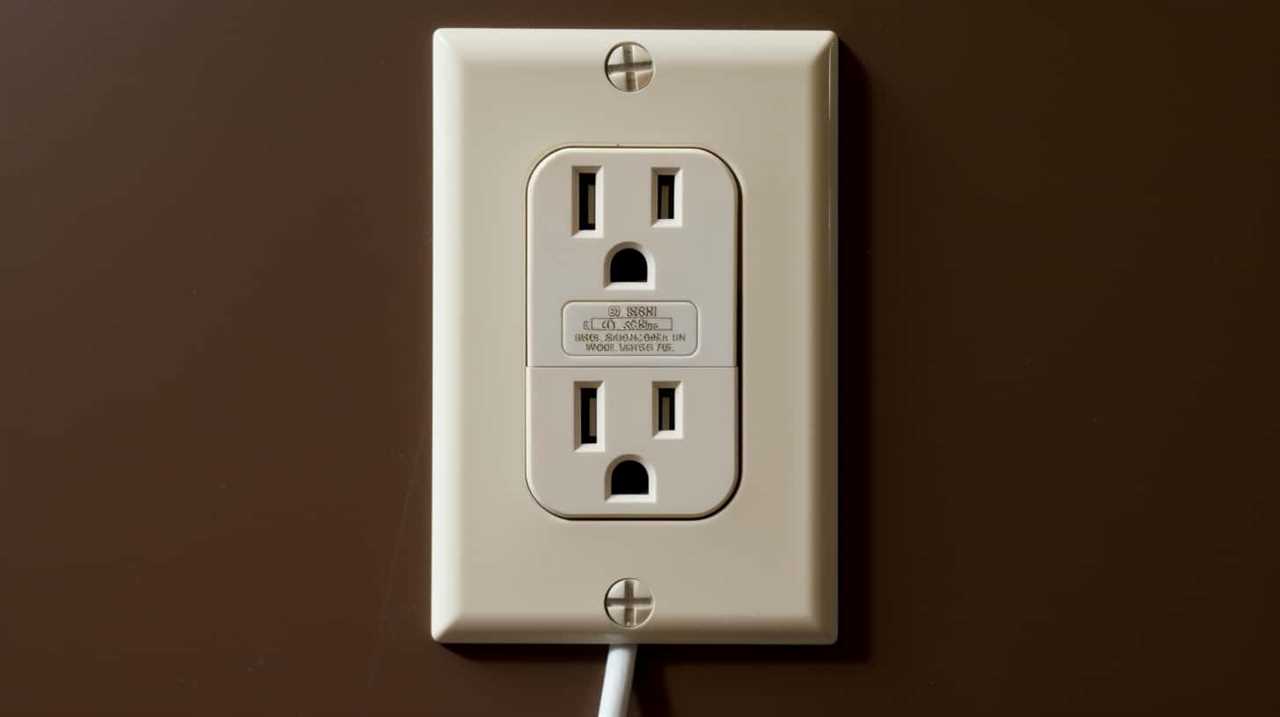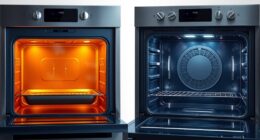Integrated appliances are in high demand due to their stylish and seamless design, but they typically come with a higher price tag than standalone models. This is because various factors contribute to their increased cost.
In this article, we will explore the reasons behind the increased expense of integrated appliances. From advanced features and technology to customization options and design flexibility, these appliances offer a level of sophistication and convenience that surpasses traditional models.
Additionally, the use of higher quality materials and construction ensures their durability and longevity. Furthermore, their integration into existing cabinetry and increased storage capacity provide a harmonious and functional kitchen space.
Lastly, the superior aesthetic appeal and brand positioning of integrated appliances contribute to their elevated value and desirability in the luxury market. Understanding these factors allows homeowners to make informed decisions when investing in their kitchen appliances.

Key Takeaways
- Integrated appliances incorporate advanced features and cutting-edge technology, which require extensive research, development, and implementation.
- Integrated appliances offer customization options and design flexibility, allowing homeowners to create a personalized and cohesive kitchen aesthetic.
- Integrated appliances use higher quality materials and construction techniques, resulting in superior durability and reliability.
- Integrated appliances showcase superior craftsmanship and design, enhancing the overall aesthetic of the kitchen and providing a functional and efficient workspace.
Advanced Features and Technology
Integrated appliances command higher prices due to their incorporation of advanced features and cutting-edge technology. These appliances are equipped with state-of-the-art technology that enhances their functionality and performance. The advanced technology features not only provide convenience but also improve the overall user experience. For example, integrated appliances may include touch-screen interfaces, smart home integration, and energy-efficient capabilities. These features require extensive research, development, and implementation, which contribute to the higher cost of these appliances.
When considering the cost of integrated appliances, it is important to weigh the benefits against the price tag. The advanced technology features can significantly improve efficiency and productivity in the kitchen, saving time and effort in the long run. Additionally, the durability and reliability of these appliances are often superior, reducing the need for frequent repairs or replacements.
Transitioning into the subsequent section about customization options and design flexibility, it is worth noting that these advanced features also provide opportunities for customization and design integration within the kitchen space.
Customization Options and Design Flexibility
The incorporation of advanced features and cutting-edge technology in integrated appliances not only enhances functionality and performance but also provides ample customization options and design flexibility.

When it comes to customization options, integrated appliances offer a wide range of choices to suit individual preferences and needs. These options can include adjustable shelving, interchangeable panels, and customizable temperature settings.
Design flexibility is another key advantage of integrated appliances. With the ability to seamlessly blend into any kitchen design, these appliances offer a sleek and cohesive look. Moreover, they can be integrated into cabinetry or hidden behind custom panels to create a seamless and integrated appearance.
This design flexibility allows homeowners to create a personalized and cohesive kitchen aesthetic, making integrated appliances a popular choice for those seeking a customized and stylish kitchen space.
Higher Quality Materials and Construction
Integrated appliances are more expensive due to the use of premium materials and superior craftsmanship. These appliances are constructed using top-quality materials that are designed to last longer and withstand daily wear and tear.

The attention to detail and precision in their construction ensures a higher level of performance and durability, making them worth the higher price tag.
Premium Materials Used
One of the reasons integrated appliances have a higher price point is due to the utilization of premium materials and superior construction techniques. These appliances are designed to not only perform well but also to look aesthetically pleasing in a kitchen setting.
Here are three reasons why premium materials are used in integrated appliances:
- Premium finishes: Integrated appliances often feature high-quality finishes such as stainless steel, glass, or ceramic. These finishes not only enhance the visual appeal of the appliances but also provide durability and resistance to scratches and stains.
- Increased longevity: The use of premium materials ensures that integrated appliances are built to last. For example, stainless steel exteriors are resistant to corrosion and can withstand heavy usage. This longevity contributes to the higher price point as consumers can expect their integrated appliances to remain functional for a longer period.
- Superior construction: Integrated appliances are constructed with attention to detail and precision. The combination of premium materials and superior construction techniques results in appliances that are sturdy, reliable, and able to withstand the demands of daily use.
Superior Craftsmanship and Design
Utilizing higher quality materials and employing superior construction techniques, integrated appliances showcase exceptional craftsmanship and design. These appliances are built to last, with a focus on durability and longevity. The superior craftsmanship is evident in the attention to detail and precision in every aspect of the appliance’s design. From the high-quality materials used in construction to the seamless integration into the kitchen cabinetry, integrated appliances offer a level of sophistication and elegance that is unmatched by their standalone counterparts. The design flexibility of integrated appliances allows for seamless integration into any kitchen style, from modern to traditional. With their sleek and streamlined appearance, these appliances not only enhance the overall aesthetic of the kitchen but also provide a functional and efficient workspace. The investment in superior craftsmanship and design is what sets integrated appliances apart and justifies their higher price tag.

| Superior Craftsmanship and Design |
|---|
| – Utilize higher quality materials |
| – Employ superior construction techniques |
| – Showcase exceptional attention to detail |
| – Offer design flexibility |
Table: Key Features of Superior Craftsmanship and Design in Integrated Appliances
Enhanced Functionality and Performance
Enhanced functionality and performance are key factors that contribute to the higher cost of integrated appliances. Advanced technology, such as smart features and innovative functions, requires additional research and development, which increases the overall cost.
Additionally, the streamlined design of integrated appliances, which focuses on seamless integration and space optimization, adds to the manufacturing complexity and cost.
Lastly, customization options, such as personalized settings and configurations, drive up prices as they require additional engineering and production processes.

Advanced Technology Costs
Integrated appliances are more expensive due to the incorporation of advanced technology, which enhances the functionality and performance of the products. These advanced technologies come with additional costs, driving up the overall price of integrated appliances.
Here are three sub-lists that demonstrate how advanced technology costs contribute to increased functionality:
- Cutting-edge sensors: Integrated appliances often feature advanced sensors that can detect changes in temperature, humidity, and other environmental factors. These sensors enable precise control and monitoring, providing users with greater convenience and efficiency.
- Smart connectivity: Integrated appliances can be connected to the internet, allowing for remote control and monitoring through smartphone apps or voice assistants. This connectivity enhances usability and convenience, but it also requires sophisticated software and hardware components, resulting in higher costs.
- Energy-efficient features: Advanced technology enables integrated appliances to optimize energy consumption and reduce waste. This includes features like automatic shut-off, adaptive cooking functions, and energy usage monitoring. While these features contribute to increased functionality and cost savings in the long run, they require advanced technology and engineering expertise, thereby increasing the price of the appliances.
Streamlined Design Increases Cost
Due to the incorporation of a streamlined design, the cost of integrated appliances is increased. This is primarily due to the enhanced functionality and performance that comes with such a design. Streamlined design allows for a seamless integration of appliances into the overall kitchen design, creating a visually appealing and cohesive look. However, this level of customization comes at a cost.
Integrated appliances often require customization to fit perfectly within the kitchen cabinetry, which increases the overall cost of the appliance. Additionally, the streamlined design often incorporates advanced technology and materials that contribute to the increased cost. Moreover, integrated appliances are known for their energy efficiency, which comes with a premium price tag.

These factors combined contribute to the higher cost of integrated appliances compared to their standalone counterparts.
Customization Drives up Prices
The demand for enhanced functionality and performance in integrated appliances drives up prices through the customization required for seamless integration into the overall kitchen design. Customization benefits include the ability to personalize appliance features to suit specific needs and preferences.
For example, customers can choose the size, color, and placement of their appliances to create a cohesive and visually appealing kitchen layout. Additionally, customization allows for the integration of advanced technologies such as smart home capabilities and energy-efficient options.
However, customization also has its limitations, as it requires specialized manufacturing processes and materials, which can increase production costs. Moreover, the customization process may lengthen the production time, leading to higher labor costs. As a result, the added customization drives up the prices of integrated appliances.

Moving forward, we will discuss how integration into existing cabinetry further contributes to the higher costs of integrated appliances.
Integration Into Existing Cabinetry
When integrating appliances into existing cabinetry, homeowners must carefully consider the compatibility and dimensions of their current setup. Custom cabinetry is often required to ensure a seamless integration, which can drive up the overall cost of the project.
Hidden appliances, such as built-in refrigerators or dishwashers, require precise measurements and modifications to the existing cabinetry in order to achieve a cohesive look. This level of customization adds an extra layer of complexity and labor to the installation process, contributing to the higher price tag of integrated appliances.
Additionally, homeowners may need to make adjustments to the electrical and plumbing systems to accommodate the new appliances, further increasing the cost.

Ultimately, integrating appliances into existing cabinetry requires meticulous planning and expertise, which is why professional installation and assistance is often recommended.
Professional Installation and Expertise Required
Integrating appliances into existing cabinetry necessitates the professional expertise of installation specialists to ensure a seamless and precise fit. Professional installation is crucial when it comes to integrated appliances for several reasons:
- Precision: Installing integrated appliances requires expert knowledge to accurately measure and fit them within the existing cabinetry, ensuring a seamless integration that enhances the overall aesthetic appeal of the kitchen.
- Technical Expertise: Professionals have the necessary skills and experience to handle the complex wiring and plumbing involved in integrating appliances, minimizing the risk of damage or malfunctions.
- Warranty and Insurance: Hiring professionals for installation ensures that the appliances are installed correctly, protecting the warranty and any insurance coverage that may be in place.
Additional Wiring and Plumbing Considerations
Installing integrated appliances requires careful consideration of additional wiring and plumbing requirements within the existing cabinetry.
When integrating appliances into a kitchen design, it is essential to ensure that there is adequate plumbing installation and electrical requirements to support the appliances. This means that the cabinetry needs to be modified to accommodate the necessary plumbing connections, such as water supply and drainage pipes, as well as electrical wiring for power supply.

These additional considerations can increase the complexity and cost of the installation process. However, they are necessary to ensure that the integrated appliances function properly and seamlessly within the kitchen layout.
Once the wiring and plumbing requirements are met, integrated appliances offer greater energy efficiency and sustainability, making them a worthwhile investment for homeowners seeking a more eco-friendly kitchen.
Greater Energy Efficiency and Sustainability
Integrated appliances offer greater energy efficiency and sustainability due to their seamless integration within the kitchen layout. This integration allows for optimized performance and reduced energy consumption, resulting in greater energy savings for homeowners.
Here are some key reasons why integrated appliances are more energy efficient and sustainable:

- Improved insulation: Integrated appliances are designed to fit perfectly within cabinetry, ensuring better insulation and preventing energy loss.
- Smart technology: Many integrated appliances come with advanced features such as energy-saving modes, timers, and sensors that optimize energy usage.
- Reduced environmental impact: By consuming less energy, integrated appliances help to reduce greenhouse gas emissions and contribute to a more sustainable environment.
With their focus on energy efficiency and sustainability, integrated appliances provide homeowners with an environmentally-friendly solution that aligns with their desire for greater energy savings and reduced environmental impact.
This emphasis on sustainability also extends to the next subtopic, which explores the longer lifespan and durability of integrated appliances.
Longer Lifespan and Durability
Designed with high-quality materials and built to withstand the demands of daily use, integrated appliances offer a longer lifespan and exceptional durability. This longevity benefits consumers in several ways.
Firstly, it reduces the need for frequent replacements, saving them money in the long run. As integrated appliances are built to last, they can withstand heavy usage without compromising their performance. This ensures that consumers can rely on their appliances for many years without experiencing any significant issues.

Additionally, the durability of integrated appliances makes them cost-effective by minimizing repair and maintenance costs. With their robust construction and high-quality components, integrated appliances provide a reliable and efficient solution for households.
Higher Maintenance and Repair Costs
Integrated appliances often have complex internal components that require specialized training and expertise to repair. This means that the cost of hiring a technician who is knowledgeable in integrated appliance repairs can be higher compared to traditional appliances.
Additionally, the availability of specialized parts for integrated appliances may be limited, further increasing the maintenance and repair costs.
Complex Internal Components
Integrated appliances come with a higher price tag due to the intricate internal components, which result in increased maintenance and repair costs. The complex assembly process involved in creating integrated appliances requires specialized manufacturing techniques and precision engineering. This complexity leads to higher production costs, which are ultimately passed on to the consumer.

The intricate internal components of integrated appliances, such as circuit boards, motors, and sensors, require specialized knowledge and expertise to maintain and repair. Here are three reasons why the complex internal components of integrated appliances contribute to higher maintenance and repair costs:
- Specialized parts: Integrated appliances often require specific, custom-made parts that can be expensive to replace.
- Technological advancements: Integrated appliances are equipped with advanced features and technology, making repairs more complicated and time-consuming.
- Specialized technician expertise: Repairing integrated appliances requires specialized training and knowledge, which can drive up the cost of maintenance and repairs.
Understanding the complexity of integrated appliances’ internal components helps explain why their maintenance and repair costs are higher. Now, let’s delve into the importance of specialized technician training in the next section.
Specialized Technician Training
To ensure proper maintenance and repair of integrated appliances, specialized technician training is essential. Integrated appliances are complex systems that require specific knowledge and skills to diagnose and fix issues effectively. This specialized technician certification goes beyond basic appliance repair training and focuses on the intricacies of integrated appliances.
These technicians are trained to understand the unique challenges and components of integrated appliances, such as their advanced control systems, advanced refrigeration technologies, and complex wiring configurations. As a result, their expertise allows them to provide accurate diagnoses and efficient repairs, ensuring the longevity and optimal performance of these appliances.

However, this specialized training comes at a cost, which contributes to the higher maintenance and repair costs associated with integrated appliances. Nonetheless, investing in specialized technician training is crucial to ensure the proper care and upkeep of these advanced and expensive appliances.
Limited Availability and Specialized Manufacturing
The limited availability and specialized manufacturing processes contribute to the higher cost of integrated appliances. Integrated appliances require specialized manufacturing techniques that are more complex and time-consuming than those used for standalone appliances. This results in increased production costs, which are then passed on to the consumer.
Additionally, the production capacity for integrated appliances is often limited due to their complex design and specialized nature. This limited production capacity further drives up the cost, as manufacturers cannot achieve economies of scale.
Furthermore, the specialized manufacturing processes and limited availability of integrated appliances often require manufacturers to invest in specialized equipment and tools, which adds to the overall cost of production.

As a result, the limited availability and specialized manufacturing techniques contribute to the higher price tag of integrated appliances.
Increased Storage Capacity and Organization
Integrated appliances offer increased storage capacity and organization in the kitchen. By efficiently utilizing space, these appliances allow for more items to be stored and easily accessible.
This streamlined design not only enhances the functionality of the kitchen but also contributes to a more organized and visually appealing space.
Efficient Use of Space
One significant advantage of integrated appliances is their ability to maximize storage capacity and organization through efficient use of space. This efficient use of space allows homeowners to optimize their storage solutions, making their kitchen more functional and organized.

Here are three ways in which integrated appliances achieve this:
- Customizable storage options: Integrated appliances offer customizable storage options, such as adjustable shelves and drawers, allowing homeowners to optimize the use of every inch of space.
- Space-saving designs: Integrated appliances are designed to fit seamlessly into cabinetry, saving valuable floor and counter space. This allows for a more efficient layout and maximizes storage capacity.
- Clever storage solutions: Integrated appliances often come with clever storage solutions, such as built-in spice racks, wine racks, and pull-out pantry shelves. These features make it easier to keep items organized and accessible.
Streamlined Kitchen Design
To further enhance the efficient use of space, integrated appliances contribute to a streamlined kitchen design, resulting in increased storage capacity and organization.
By integrating appliances such as refrigerators, dishwashers, and ovens into the kitchen cabinetry, valuable floor and counter space can be saved. This streamlined functionality eliminates the need for standalone appliances, allowing for a more seamless and cohesive kitchen design.
Additionally, integrated appliances are designed to maximize space optimization by utilizing every available inch of storage. Cabinets and drawers can be custom-built to accommodate specific appliance sizes, ensuring a perfect fit and eliminating wasted space. This not only increases storage capacity but also promotes better organization by providing designated spaces for each appliance.

In this way, integrated appliances contribute to a clutter-free and efficient kitchen environment.
Enhanced Accessibility and Functionality
By optimizing storage capacity and promoting better organization, integrated appliances enhance accessibility and functionality in the kitchen. These appliances are designed to maximize the use of available space, allowing users to store more items efficiently.
Here are three ways in which integrated appliances enhance accessibility and improve functionality:
- Increased Storage Capacity: Integrated appliances offer larger storage capacities compared to traditional standalone appliances. This allows users to store more food, cookware, and other kitchen essentials, making it easier to keep everything organized and accessible.
- Improved Organization: Integrated appliances come with built-in storage solutions such as adjustable shelves, dividers, and specialized compartments. These features help users organize their items more effectively, reducing clutter and making it easier to find what they need quickly.
- Customization Options: Integrated appliances can be customized to fit the specific needs and preferences of the user. This includes features like adjustable shelving heights, removable bins, and flexible storage configurations, allowing users to personalize their appliance to suit their unique requirements.
With enhanced accessibility and improved functionality, integrated appliances offer a more efficient and convenient kitchen experience.

Superior Aesthetic Appeal and Seamless Design
Achieving a superior aesthetic appeal and seamless design is one of the factors contributing to the higher cost of integrated appliances. These appliances are designed to blend seamlessly with the existing kitchen decor, creating a cohesive and visually appealing space.
The seamless installation of integrated appliances ensures that there are no visible gaps or inconsistencies, giving the kitchen a sleek and polished look. This level of attention to detail requires precise engineering and craftsmanship, which adds to the overall cost of the appliances.
Additionally, integrated appliances often feature high-end materials and finishes that further enhance their aesthetic appeal. The seamless integration of these appliances into the kitchen design not only elevates the overall look but also creates a sense of sophistication and luxury.
Therefore, the superior aesthetic appeal and seamless design of integrated appliances contribute to their higher price point.

Enhanced Home Value and Resale Potential
The enhanced home value and resale potential of integrated appliances make them a worthwhile investment for homeowners. When considering the purchase of integrated appliances, homeowners can expect the following benefits:
- Increased home value: Integrated appliances are seen as a premium feature in homes, which can raise the overall value of the property. Potential buyers are often willing to pay a higher price for a home that already includes integrated appliances, saving them the cost and hassle of installing them later.
- Improved marketability: Homes equipped with integrated appliances have a competitive edge in the real estate market. These appliances provide a modern and sleek aesthetic appeal that attracts buyers and sets the home apart from others.
- Faster resale: With the added appeal of integrated appliances, homes tend to sell faster than those without them. Buyers recognize the convenience and luxury of having these appliances seamlessly integrated into the design of the home.
Investing in integrated appliances not only enhances the functionality and aesthetics of a home but also increases its value and resale potential.
Exclusive Brand and Luxury Market Positioning
Integrated appliances command a higher price due to their association with exclusive brands and their positioning in the luxury market. The concept of brand exclusivity plays a significant role in the pricing strategy of integrated appliances.
Exclusive brands invest heavily in research and development to create innovative, high-quality products that cater to the demands of the luxury market. These brands develop a reputation for excellence and craftsmanship, which allows them to charge a premium for their products.

Additionally, luxury market demand further drives up the price of integrated appliances. Consumers who seek a luxurious lifestyle are willing to pay more for appliances that offer advanced features, sleek designs, and seamless integration into their homes.
As a result, integrated appliances become synonymous with luxury, attracting a niche market willing to pay a premium for exclusivity and prestige.
Frequently Asked Questions
Are Integrated Appliances More Energy Efficient Than Traditional Appliances?
Integrated appliances are generally more energy efficient than traditional models due to their advanced energy-saving features. This increased efficiency can lead to long-term cost savings and improved overall cost-effectiveness of integrated appliances.
What Are Some Maintenance and Repair Costs Associated With Integrated Appliances?
When considering maintenance and repair costs, it is important to be aware of the potential expenses associated with integrated appliances. These costs can vary depending on the type of appliance and the complexity of repairs required.

Are Integrated Appliances Available in a Wide Range of Sizes and Styles to Fit Different Kitchen Layouts?
Integrated appliances are available in a wide range of sizes and styles, making them suitable for various kitchen layouts. The integration of these appliances offers a seamless and cohesive look, which is one of the pros of choosing integrated appliances over stand-alone ones.
How Long Can I Expect Integrated Appliances to Last Compared to Traditional Appliances?
Integrated appliances tend to have a longer lifespan compared to traditional appliances due to their higher build quality, superior materials, and advanced technology. Factors such as durability, reliability, and efficiency contribute to their longevity.
Do Integrated Appliances Require Specialized Installation or Can They Be Easily Installed by Homeowners?
Specialized installation may be required for integrated appliances, as they often need to be seamlessly incorporated into cabinetry. While some homeowners may be able to install them with proper instructions, it is recommended to seek professional assistance to ensure proper functionality and durability.
Conclusion
In conclusion, integrated appliances are more expensive due to their advanced features, customization options, higher quality materials, enhanced functionality, integration into existing cabinetry, increased storage capacity, superior aesthetic appeal, and exclusive brand positioning.

They offer a seamless design that adds value to homes and has a positive impact on resale potential.
Integrated appliances can be likened to a well-tailored suit that seamlessly blends into a person’s overall appearance, enhancing their overall style and sophistication.










